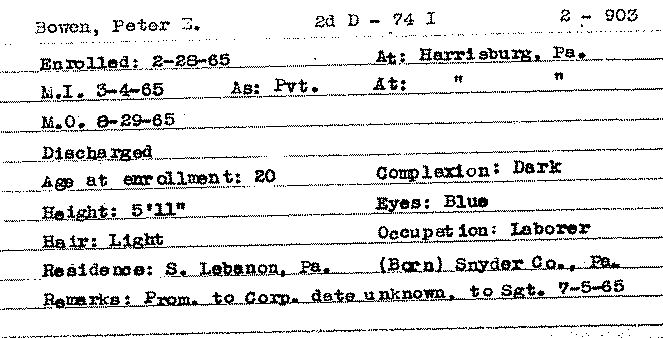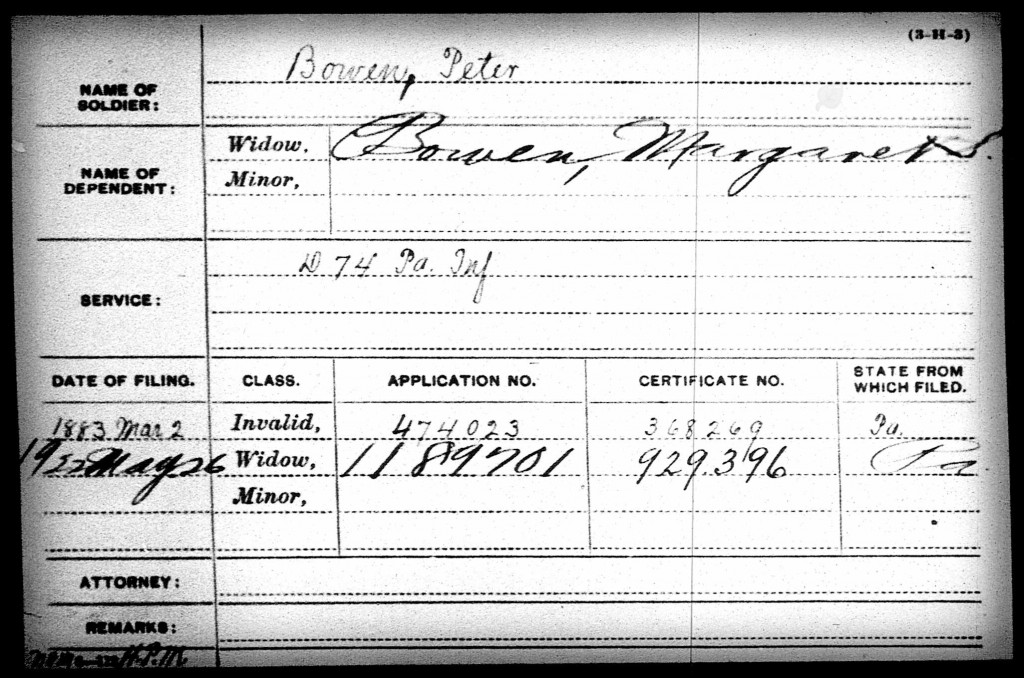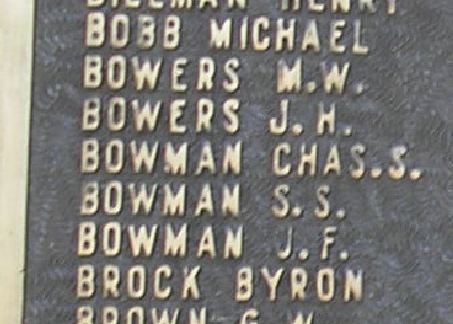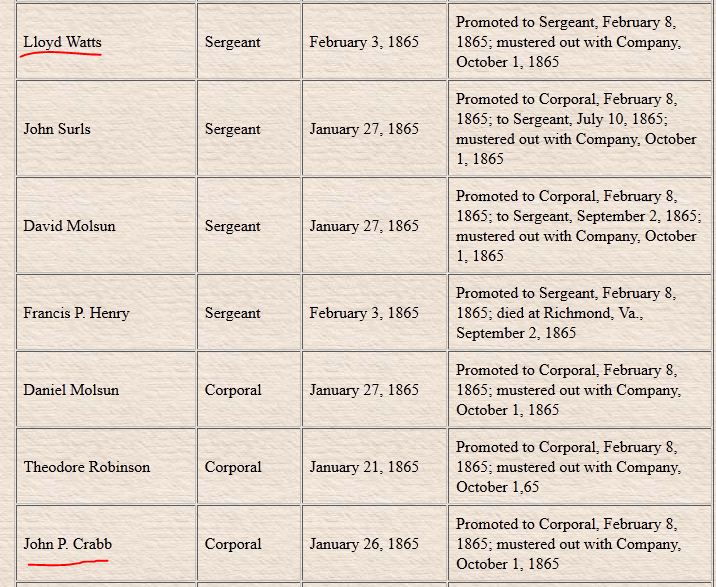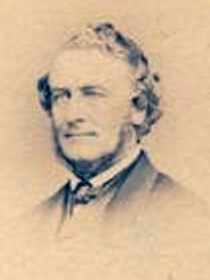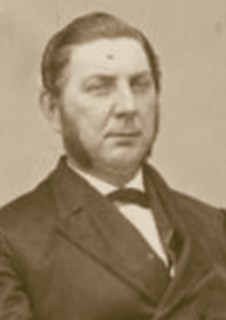Posted By Norman Gasbarro on December 4, 2012
In a section describing John A. Sipe, found in the Genealogical and Biographical Annals of Northumberland County Pennsylvania (1911), no less than ten Civil War veterans are mentioned in his extended family. John A. Sipe was a merchant tailor who had a post-Civil War business that centered in Herndon, Northumberland County, Pennsylvania, but operated in the rail and river corridor from Millersburg to Sunbury.
In Friday’s post the full biographical entry was presented along with follow-up information about the military service of John A. Sipe. his father, Jacob Sipe, and his uncle, Jeremiah Sipe. In Saturday’s post, Jacob Henry Sipe, the brother of John A. Sipe, and William Ickes., the half-brother of John A. Sipe, were presented. In Sunday’s post, the three Vanaman brothers’ service in the Civil War was noted; David Vanaman, George Vanaman and Thomas Vanaman were brothers of John A. Sipe‘s wife, Eva [Vanaman] Sipe. Finally, in the post today, the two other brothers-in-law of John A. Sipe, Monroe Chronster and Hiram M. Jacobs will be presented.
——————————-
MONROE CHRONSTER/EMANUEL CHRONISTER (1842-1900)
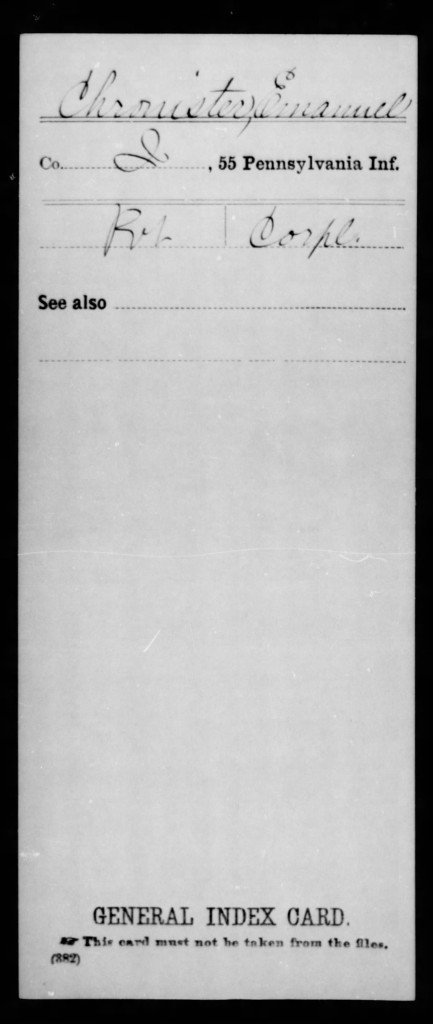
Monroe Chronster, who married John A. Sipe‘s sister, Jennie Sipe, is possibly the same person as Emanuel Chronster or Emanuel Chronister as the name is most often found in the records. While the Annals of Northumberland County states that he served in the 93rd Pennsylvania Infantry, no person of the name Chronister has yet been located in the records of that regiment. An Emanuel Chronister has been located in the records of the 55th Pennsylvania Infantry, Company I as shown (above) by the Military Index Card found at Fold3. This Emanuel Chronister is apparently the same person, who in 1890 (below), reported his service in the 56th Pennsylvania Infantry, Company I, with service dates of 20 March 1865 through 1 July 1865.

Click on document to enlarge.
The 1890 Census post office location for Emanuel Chronister was Hampton, Adams County, Pennsylvania – which is the location given for the Monroe Chronster named in the Annals of Northumberland County. No Monroe Chronster was found in that location in 1890.
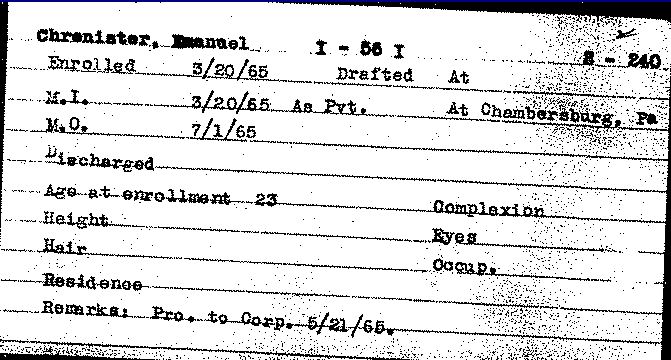
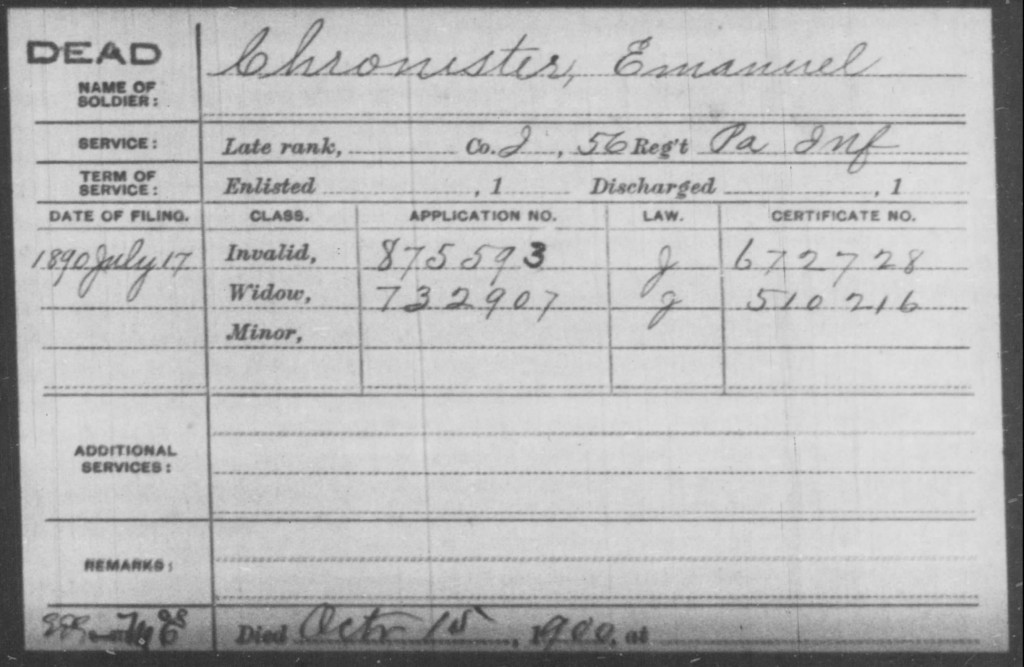
The Pennsylvania Veterans’ Index Card (above), which references records at the Pennsylvania Archives and in Bates (Volume 2, page 240), states that Emanuel Chronister was drafted into the 56th Pennsylvania Infantry, Company I, as a Private on 20 March 1865 at Chambersburg, was promoted to Corporal on 21 May 1865, and was mustered out on 1 July 1866 [sic]. At the time of his muster in, he was 23 years old, with no other descriptive information given. The Pension Index Card available from Fold3 (above) states that his initial invalid pension application was made on 17 July 1890 and that a widow’s application was made (no date given). A death date for Emanuel Chronister is given as 15 October 1900.
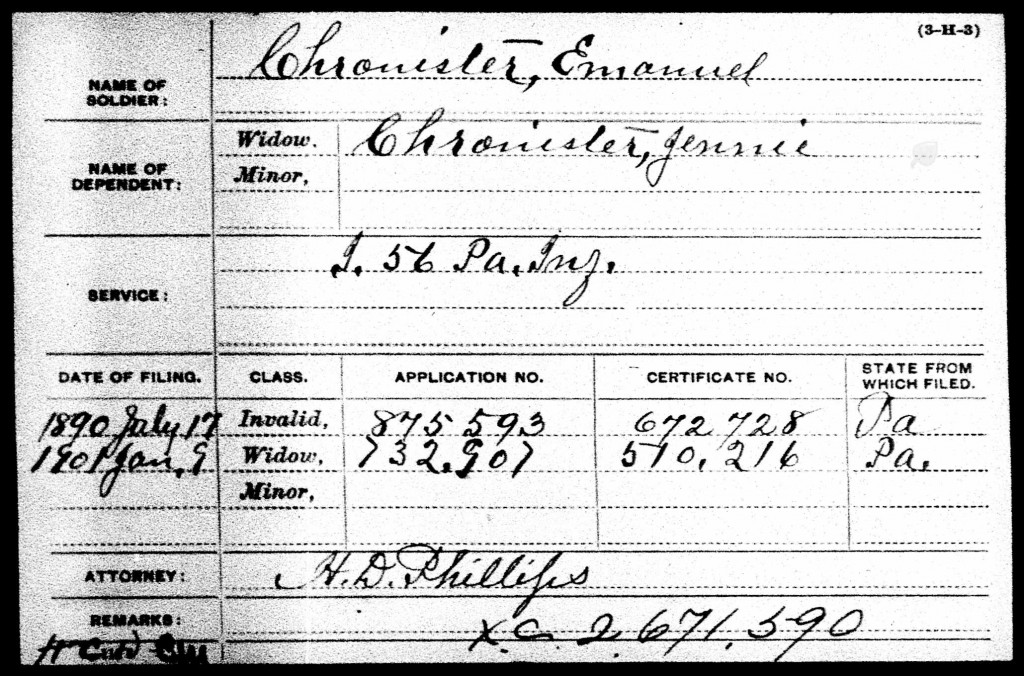
The Pension Index Card available from Ancestry.com (above) names the widow as “Jennie Chronister.”

The grave marker for Emanuel Chronister who died in 1900 was found through Findagrave in the Hampton Union Cemetery, Hampton, Adams County, Pennsylvania. At the same site, his wife, Jennie [Sipe] Chronister (1848-1944) is buried.
The York County Heritage Trust notes the following personal information about Emanuel Chronister:
Son of Levi Chronister & Rachel Chronister.
Siblings: David Chronister, Aaron Chronister, Moses Chronister, Jonas Chronister, Sarah Ann Chronister, Brough Chronister, and Rachel Chronister.
Occupation: Carpenter
Married Jennie L. Sipe.
Children: Nettie Chronister (born about 1869); Robert J. Chronister (born about 1870); and Mabel Chronister (born about 1875).
Residence: 1890, lived in Reading Township, Adams County, Pennsylvania.
David H. Chronister (1844-1829), who is mentioned in the above database as the brother of Emanuel Chronister, served in the 138th Pennsylvania Infantry, Company G, as a Corporal and was shot in the stomach and mortally wounded at the Battle of the Wilderness, Virginia, on 6 May 1864. He died on 14 May 1864. He had enrolled at Adams County and was mustered in at Harrisburg on 17 September 1862, giving his occupation as carpenter and his residence as Middletown, Adams County, Pennsylvania. He is buried at the National Cemetery in Fredericksburg, Virginia.
This analysis has uncovered several errors. The errors in the Annals of Northumberland County include an incorrect first name of Monroe for Emanuel Chronister and an incorrect regiment of the 93rd Pennsylvania Infantry. And, there is an error on the Military Index Card (National Archives); these cards are compiled in the database, U.S. Civil War Soldiers, 1861-1865, found on Ancestry.com. The Military Index Cards state service was in the 55th Pennsylvania Infantry, but all other sources indicate service was in the 56th Pennsylvania Infantry.
——————————-
HIRAM M. JACOBS (1844-1929)
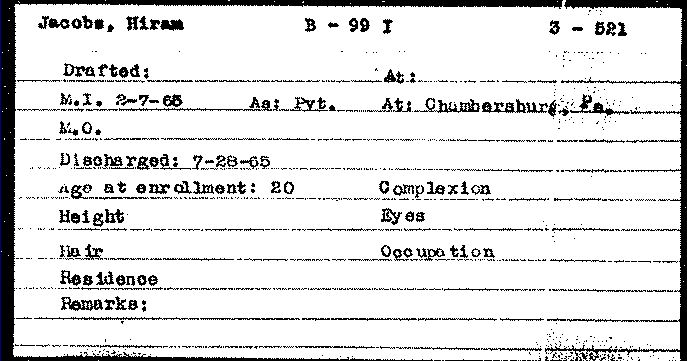
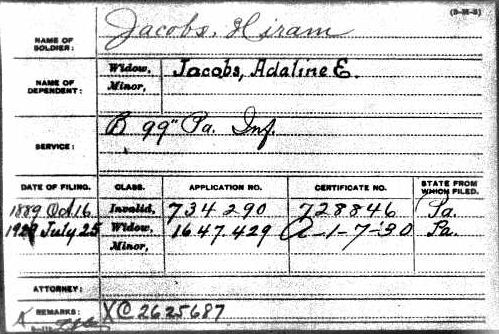
A sister of John A. Sipe, Adaline Sipe, was married to Hiram M. Jacobs. According to the Annals of Northumberland County, Hiram Jacobs served in the 90th Pennsylvania Infantry. This is incorrect. Hiram M. Jacobs served in the 99th Pennsylvania Infantry, Company B, as a Private, as clearly shown by both the Pennsylvania Veterans’ Index Card (above) and the Pension Index Card (above).
According to the Pennsylvania Veterans’ Index Card, Hiram M. Jacobs was mustered into service on 7 February 1865 at Chamberburg, Pennsylvania, at age 20. No other personal descriptive information is given on the card. He was discharged on the 28 July 1865. But, according to information given on the Pension Index Card found at Fold3 (not shown), his service dates were 27 February 1865 through 1 July 1865.
The York County Heritage Trust notes the following personal information about Hiram M. Jacobs:
Son of Michael Jacobs and Elizabeth [Asper] Jacobs.
Siblings: Juliann Jacobs; Abraham Jacobs; John Jacobs; William J. Jacobs (born 8 September 1856), and James Jacobs (born about 1862).
Married Adeline E. Sipe, 27 March 1890.
Residence: Latimore Township, Adams County, Pennsylvania.
Hiram M. Jacobs died on 4 July 1929 in Adams County, Pennsylvania.
——————————
The York County Heritage Trust Civil War Database was constructed by researcher Dennis W. Brandt from information found in the veterans’ pension application files found at the National Archives in Washington, D.C. The database contains information on Civil War veterans who had a connection to Adams County and York County, Pennsylvania. Pension Index Cards are either from Ancestry.com or Fold3. Pennsylvania Veterans’ Index Cards reference Bates as well muster rolls available at the Pennsylvania Archives. U.S. Census records are available from Ancestry.com.
Category: Research, Resources, Stories |
Comments Off on The Husbands of the Sisters of John A. Sipe – Monroe Chronister and Hiram M. Jacobs
Tags: Herndon, Millersburg
 ;
;
